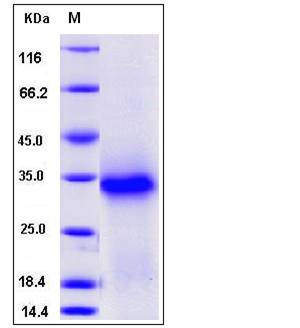Mouse TWSG1 Protein (His Tag)
1810013J15Rik,9030422N06Rik,AW552143,D17Ertd403e,Tsg,Twg
- 100ug (NPP3530) Please inquiry
| Catalog Number | P50162-M08H |
|---|---|
| Organism Species | Mouse |
| Host | Human Cells |
| Synonyms | 1810013J15Rik,9030422N06Rik,AW552143,D17Ertd403e,Tsg,Twg |
| Molecular Weight | The secreted recombinant mouse TWSG1 comprises 209 amino acids and has a calculated molecular mass of 23.6kDa. As a result of glycosylation, the apparent molecular mass of the recombinant protein is approximately 34 kDa in SDS-PAGE under reducing conditions. |
| predicted N | Cys 25 |
| SDS-PAGE |  |
| Purity | > 93 % as determined by SDS-PAGE |
| Protein Construction | A DNA sequence encoding the mouse TWSG1 (Q9EP52) (Met 1-Phe 222) was expressed, with a C-terminal polyhistidine tag. |
| Bio-activity | |
| Research Area | Neuroscience |Neurology process |Neural Signal Transduction |
| Formulation | Lyophilized from sterile PBS, pH 7.4 1. Normally 5 % - 8 % trehalose and mannitol are added as protectants before lyophilization. Specific concentrations are included in the hardcopy of COA. |
| Background | TWSG1 belongs to the twisted gastrulation protein family. TWSG1 from different species are functionally equivalent. In contrast to Drosophila where TWSG1 expression is limited to early embryos, expression of TWSG1 is found throughout mouse and human development. Mutations in the TWSG1 gene cause at least some of the cells on the dorsal half of the embryo to adopt more ventral cell fates. This is thought to involve gradients of the signaling molecule decapentaplegic. TWSG1 may function as a bone morphogenetic protein signalling agonist or antagonize these activities. It can dislodge latent bone morphogenetic proteins and thus provides a permissive signal that allows high BMP signaling in the embryo. TWSG1 is a cofactor in the antagonism of chordin to BMP signaling. It also binds both the vertebrate Decapentaplegic ortholog BMP4 and chordin and forms ternary complexes. Meanwhile, TWSG1 increases binding of chordin to BMP4, potentiates the ability of chordin to induce secondary axes in Xenopus embryos, and enhances chordin cleavage by vertebrate proteases related to tolloid at a site poorly used in the absence of TWSG1. The presence of TWSG1 enhances the secondary axis-inducing activity of 2 products of chordin cleavage. |
| Reference |
